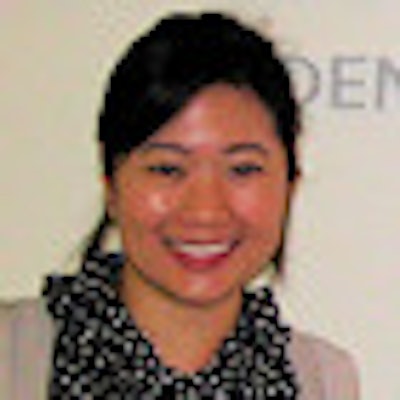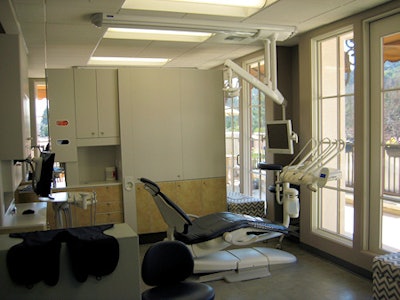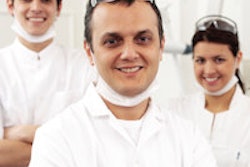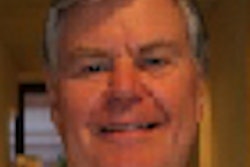
When Julia Hoang, DDS, graduated from dental school six years ago, she set a goal of taking over a practice within five years. But after trying unsuccessfully to buy the practice where she had been an associate for almost five years, she decided to take a leap of faith and open her own practice from scratch.
A little more than a year after Dr. Hoang made her daunting decision -- and after overcoming countless obstacles -- she saw her first patients last August.
The process, Dr. Hoang warns, is definitely not for the faint of heart.
 Dr. Julia Hoang opened her practice in Moraga, CA, in August 2012. All images courtesy of Dr. Hoang.
Dr. Julia Hoang opened her practice in Moraga, CA, in August 2012. All images courtesy of Dr. Hoang.
"In school, when they talk about opening from scratch or buying another practice, everyone says it's extremely difficult to open your own office," she told DrBicuspid.com while proudly showing her light-filled suite in Moraga, a suburb in the San Francisco Bay Area. "You think to yourself, 'Well, I can handle it. How bad can it be?' It's actually pretty bad,' " she laughingly recalled.
Dr. Hoang had planned to buy a practice in Orinda where she worked as an associate for four and a half years after graduating from the University of California, San Francisco School of Dentistry in 2007.
"I was supposed to buy that office twice and it didn't happen," she explained. "I did not want to open from scratch, but I was kind of convinced to do it because at that point I had to create an opportunity, rather than wait for something that wasn't working out."
Frustrated but undeterred, the diminutive, determined 32-year-old dentist opted to strike out on her own. She continued to work for a dentist in Petaluma, more than an hour's commute from her home in Walnut Creek, to supplement her income until her own practice became more established. Now that she has 180 patients, Dr. Hoang hopes to quit her second job this summer. Giving up the reliable paycheck is a risk, though.
"Not only is it taking a toll on me, but it's really hard when I have patients who want to see us," Dr. Hoang noted. "We're here three days a week and we're pretty full. If someone calls and has an emergency, it's really hard to get them in. The only way to free up more time is to work less in Petaluma, but that's hard to let go because it's a sure thing."
Community support
Dr. Hoang chose her new location because it's in the same area where she had worked before and she had the support of local specialists and patients. She had previously treated about a quarter of her patients; the rest are word-of-mouth referrals. Another helpful factor was already being in contract with many insurance companies.
“When you graduate you know a lot, but you don't have enough practice.”
"It helped to know the community and have patients, because otherwise it is very scary," Dr. Hoang noted. "There are a lot of dentists out there, and a lot of them are not doing well, and they're established. So what's going to make you different?"
Her patients say they picked her because they either heard about her or she was listed in the network of insurance company providers. Patients also tell Dr. Hoang they checked her website and read patient reviews before coming in.
"The reviews really helped because it's what patients think," Dr. Hoang said.
One of the first people who helped her was Charmen Brummer, a dentistry equipment specialist with Patterson Dental, who has helped other Bay Area dentists navigate the route to open new offices.
"In the beginning, you need that kind of person because you don't know what you need, how many you need, and what type of space it requires," Dr. Hoang said. "She went with me to all these spaces before I signed a lease to make sure the place was suitable."
Brummer also helped Dr. Hoang get a loan from Wells Fargo Bank.
"They figure out how much debt you have," said Dr. Hoang, who is still paying off her dental school loan. "The banks work with doctors with dental-specific loans, but they like to see a doctor who maintains a current practice."
One of the bank's requirements for the loan was that she keep her second job. "It is a lot of work, but it is worth it," she said.
 |
| The open layout includes two operatories that open onto a balcony. |
The dentistry is the easy part, Dr. Hoang said; building the new office space was a time-consuming challenge. Hiring architects, contractors, lawyers, and brokers and getting required permits and insurance presented seemingly endless hurdles.
"Every day I dreaded opening my email because there were 20 emails I had to respond to," she recalled. "It was nonstop for the longest time."
Bright and sunny
On the bright side, opening her own office allowed her to choose state-of-the-art equipment, such as her Panorex x-ray machine, which has very low radiation levels. She also bought a hospital-grade autoclave by A-dec, which provided most of the equipment in her 1,600-sq-ft office. Dr. Hoang also selected a Mojave dry vacuum, which avoids wasting thousands of gallons of water that traditional water vacuums use.
The open layout includes two operatories that open onto a balcony lined with flower boxes, patio tables, and umbrellas, offering a view of rolling hills. The latex-free, paperless office also offers Wi-Fi.
The sunny balcony is Dr. Hoang's favorite part of the office. "It's a family community, so parents often bring their kids, and they can come out here and enjoy the sunshine," she said.
 Dr. Hoang on her "family-friendly" deck.
Dr. Hoang on her "family-friendly" deck.
Before dentists strike out on their own, Dr. Hoang advises new ones to work in different practices to get a feel for what kind of office suits them best.
"When you graduate, you know a lot but you don't have enough practice," she said. "You don't know what you agree with, you don't know what you disagree with, you don't how to manage a staff, you don't know how large an office you want -- you don't know any of that."
After working in about a dozen offices, Dr. Hoang realized she prefers smaller practices.
"The bigger the office, the more staff you have and more turnover, and the more you're always trying to fix something for somebody," she said.
Right now Dr. Hoang only has one assistant and does all prophys herself. "In the future, as a woman, I may want to do others things like be a mom," she said. Eventually, she plans to hire an associate dentist and a hygienist.
Starting her own practice allowed Dr. Hoang to decide her own approach to dentistry, which she describes as conservative rather than aggressive. For example, she doesn't place amalgams, only composites. She also prefers to drill as little as possible.
"Older dentists were taught that if a tooth has a cavity, it's a bad tooth, so not only do you cut out the cavity but also a lot of the tooth," Dr. Hoang explained. "It's a different generation."
She adheres to modern concepts that focus on preserving as much of a tooth as possible.
"They've found that no other material is as good as your natural tooth structure, so if a person has decay, you only cut what you need," Dr. Hoang said. "The bigger the hole you cut, you're just leaving the tooth to have more trouble in the future because it will be weaker; you lose structural integrity. So if a person has a small, snake-like cavity, that's the shape of the filling you put in; you don't drill as much."
Composite bonding systems have gotten much better over the years, she noted. "So fillings can be any strange shape you want, and I can be much more conservative," she said.
Now that her office is finally up and running, she's optimistic about the future.
"If I can just get the patients to come in, see what I've invested in for them, and meet me and see how I do my dentistry, then I think word of mouth will help the office grow, and I think we'll be just fine," Dr. Hoang said.



















